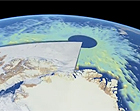The European Space Agency’s (ESA) CryoSat satellite is now providing highly accurate data on the thickness and volume of Arctic Ocean ice. Using a high-resolution
synthetic aperture radar that sends down pulses of microwave energy, the satellite can measure the difference between the top of the ice and water in the cracks, or leads, that separate the floes. By measuring the height of the ice above water, which usually represents only one-eighth of total ice thickness, the satellite can provide data on ice thickness to within 10 to 20 centimeters, or 4 to 8 inches. The CryoSat satellite was launched in 2010, and since then scientists have been validating the measurements against other data from plane-based instruments and direct, on-ice measurements. “We now have a very powerful tool to monitor the changes taking place at the poles,” said Volker Liebig, the ESA’s director of Earth Observation.
European Satellite Provides Precise Data On Arctic Sea Ice Thickness
More From E360
-
E360 Film Contest
The Amazon Rainforest Approaches a Point of No Return
-
Biodiversity
Shrinking Cod: How Humans Are Impacting the Evolution of Species
-
Cities
‘Sponge City’: How Copenhagen Is Adapting to a Wetter Future
-
INTERVIEW
On Controlling Fire, New Lessons from a Deep Indigenous Past
-
Solutions
Paying the People: Liberia’s Novel Plan to Save Its Forests
-
OPINION
Forest Service Plan Threatens the Heart of an Alaskan Wilderness
-
INTERVIEW
Pakistan’s Solar Revolution Is Bringing Power to the People
-
Food & Agriculture
In Uganda, Deadly Landslides Force an Agricultural Reckoning
-
Energy
Why U.S. Geothermal May Advance, Despite Political Headwinds
-
Food & Agriculture
In War Zones, a Race to Save Key Seeds Needed to Feed the World
-
Climate
Lightning Strikes the Arctic: What Will It Mean for the Far North?
-
RIVERS
A Win for Farmers and Tribes Brings New Hope to the Klamath
